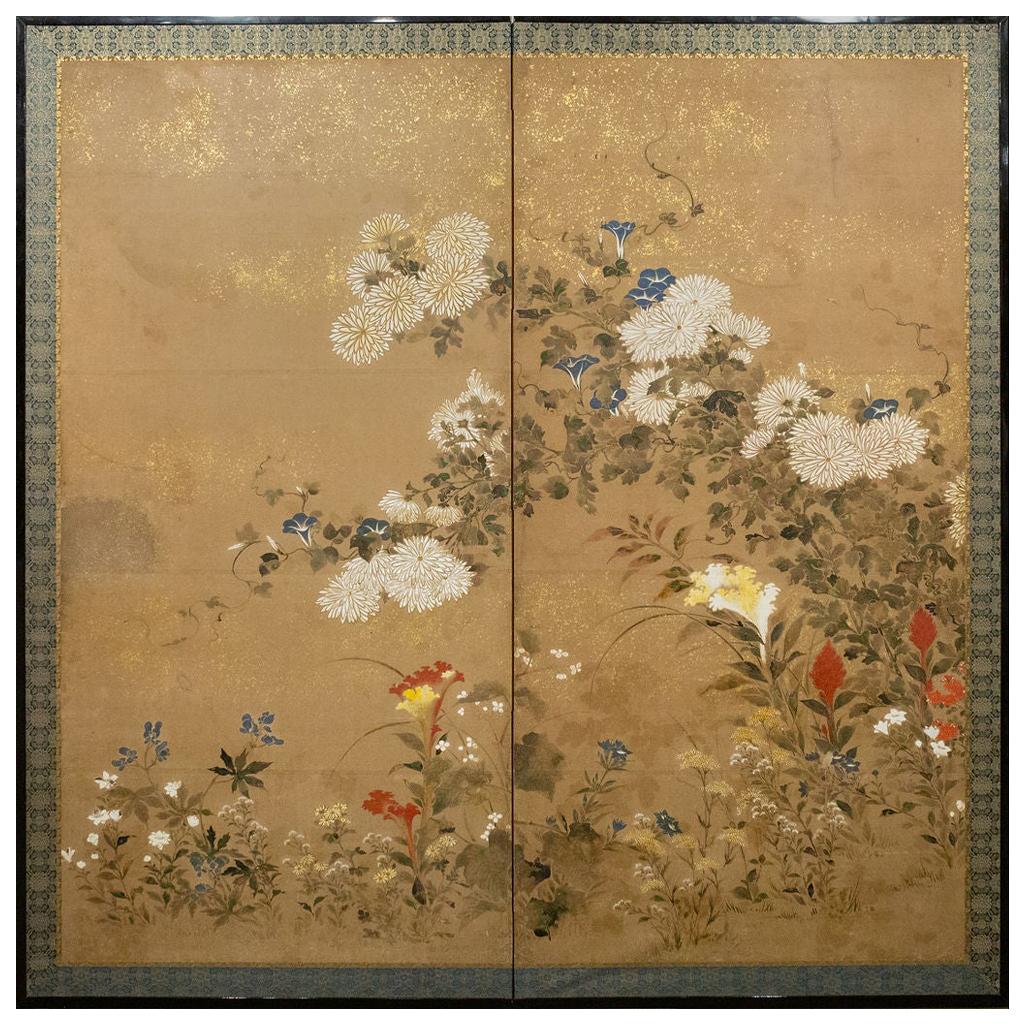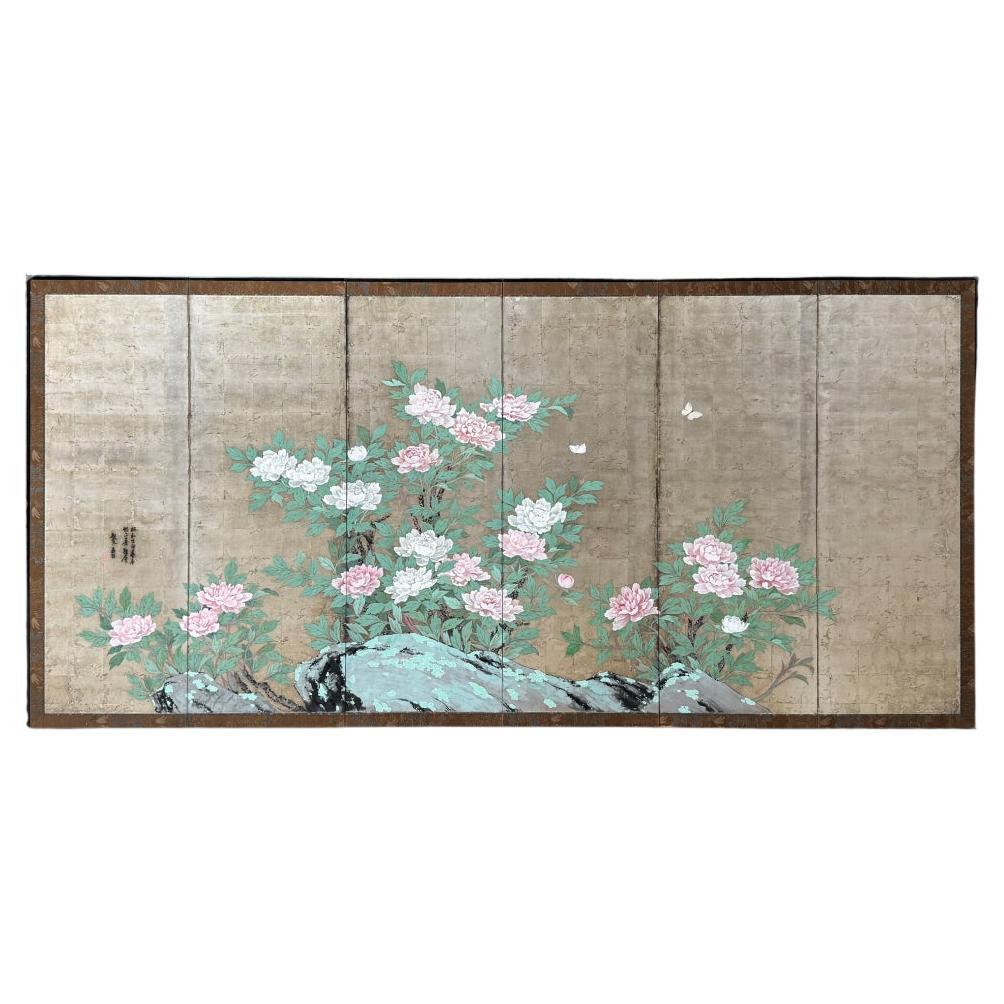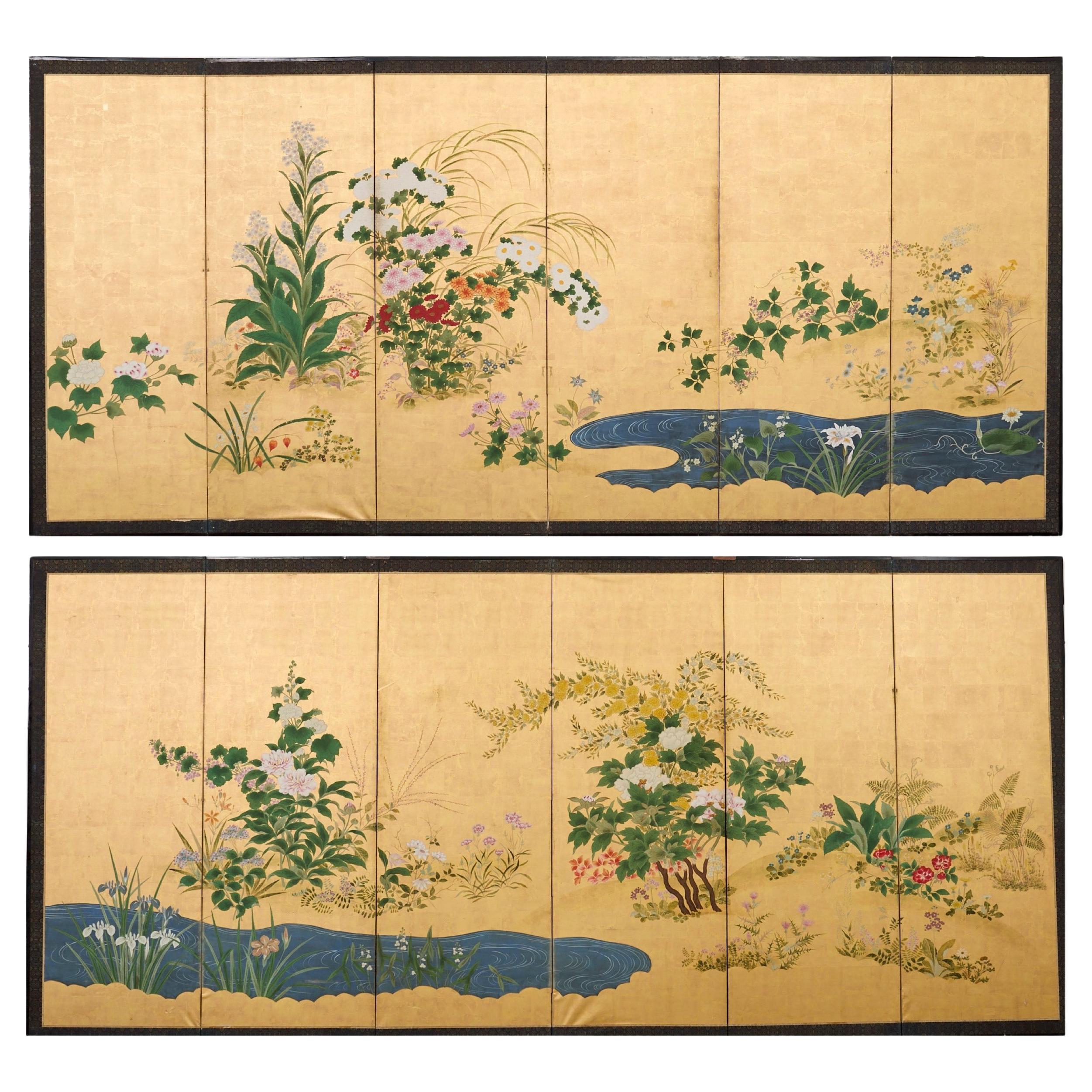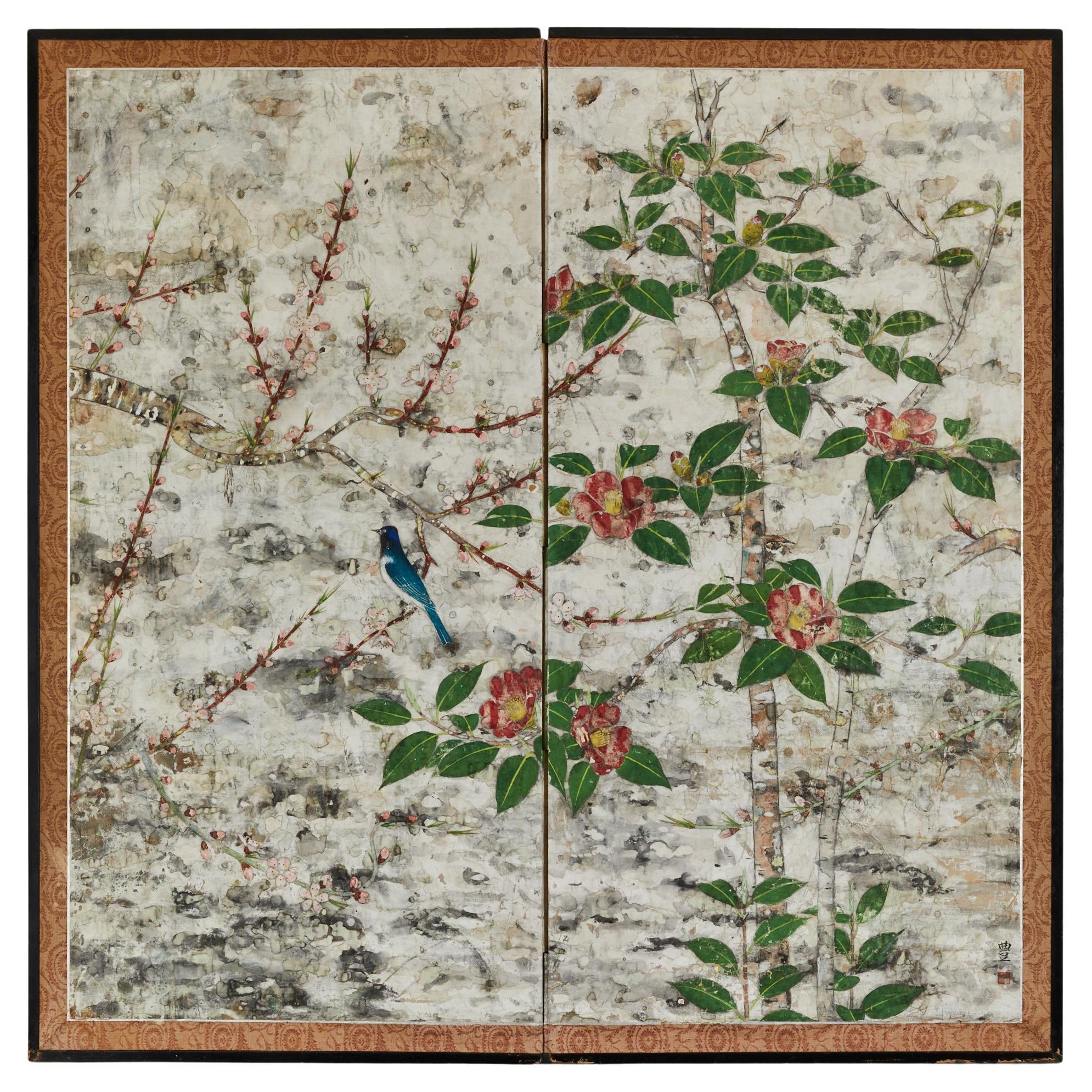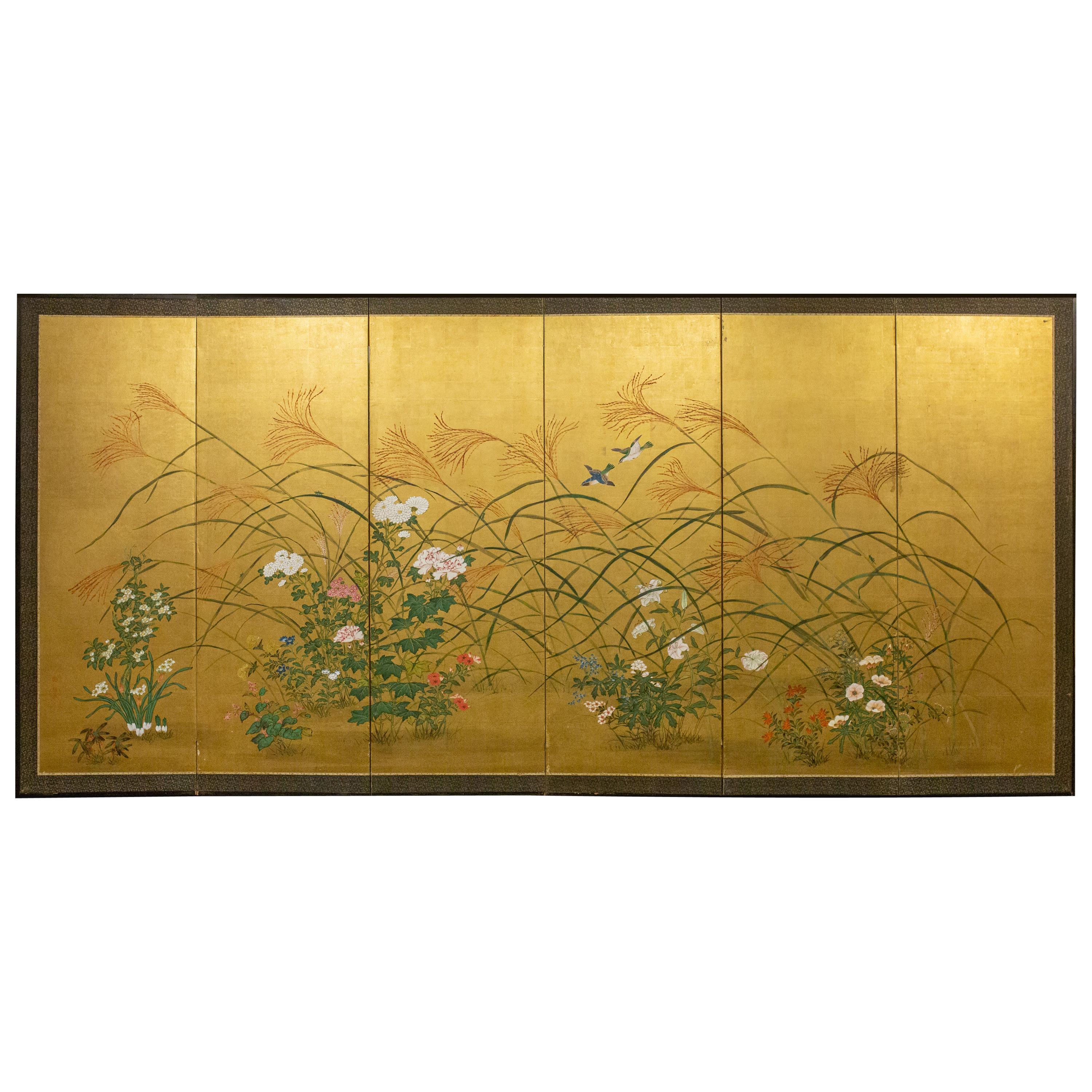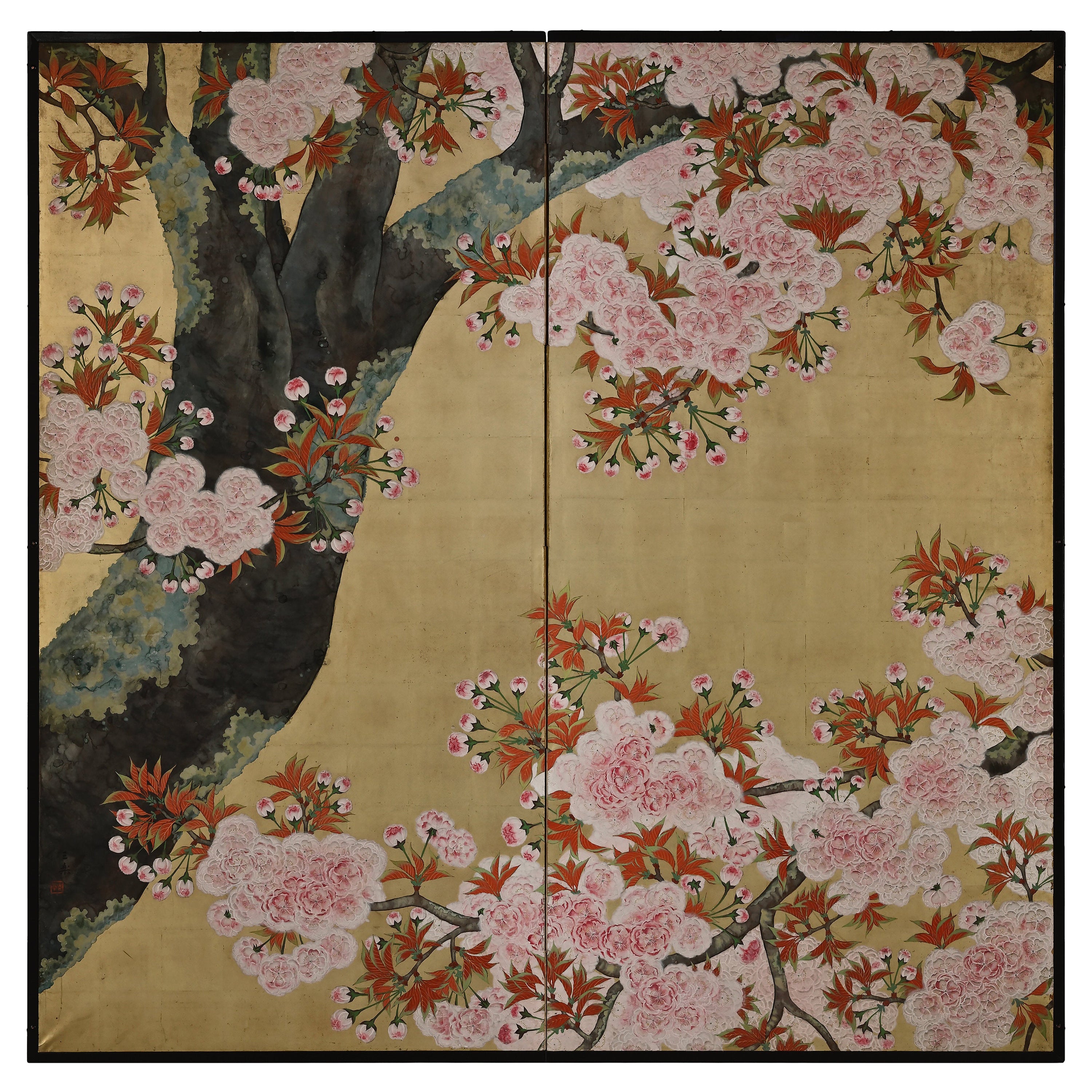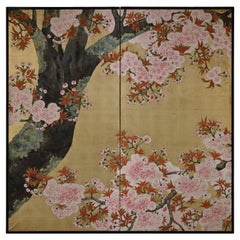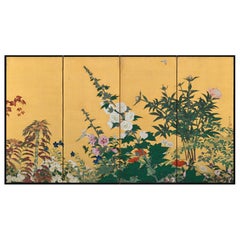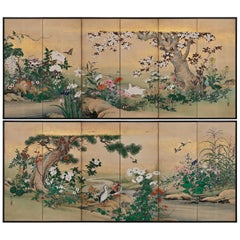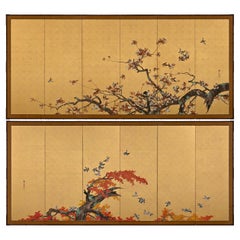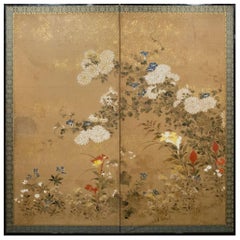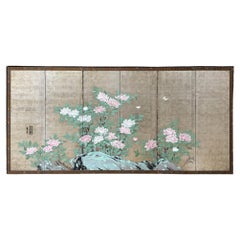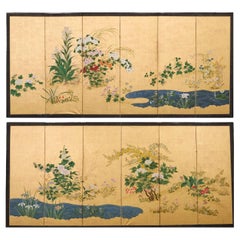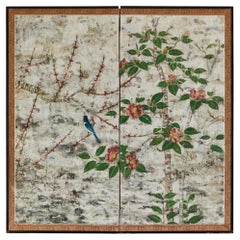Items Similar to circa 1930 Japanese Silver Screens by Isoi Joshin, Flowers of the Four Seasons
Want more images or videos?
Request additional images or videos from the seller
1 of 14
circa 1930 Japanese Silver Screens by Isoi Joshin, Flowers of the Four Seasons
$29,500
£22,383.92
€25,594.01
CA$41,203.50
A$45,812.69
CHF 23,920.86
MX$557,651.95
NOK 305,219.72
SEK 285,976.29
DKK 191,012.82
Shipping
Retrieving quote...The 1stDibs Promise:
Authenticity Guarantee,
Money-Back Guarantee,
24-Hour Cancellation
About the Item
Flowers of the four seasons
Isoi Joshin (1883-1964)
Pair of six-panel Japanese screens
Ink, pigment, lacquer and silver leaf on paper
Inscription: Isoi Jo
Seal: Shin
Dimensions:
Each screen: : W. 379 cm x H. 175.5 cm (149” x 69”)
A distinctive Japanese artistic convention is to depict a single environment transitioning from spring to summer to autumn to winter in one painting. In this way, Japanese painters expressed not only their fondness for this natural cycle but also captured an awareness of the inevitability of change, a fundamental Buddhist concept. This pair of screens by Isoi Joshin celebrate not only the sensual appeal of elements of the natural world, but also imbue them with human emotions. Amongst a myriad of plants and flowers of varying degrees of recognizability are ferns, thistles, reeds and bush clover. Butterflies and dragonflies hover above them. The natural elements, being employed as decorative motifs, have been stylized to heighten the ornamental effect.
First and foremost a lacquer artist, Isoi Joshin has transferred these skills to the expansive silver-leaf canvas of this pair of six-fold screens. Along with traditional Japanese ink and pigments Joshin has also utilized lacquer in these paintings. This has led to some extraordinary colors which are unseen before in screen painting.
Born in Takamatsu, Isoi Joshin first studied lacquer arts at the Kagawa Prefectural Crafts School. After graduating in 1903 he moved to Osaka for a time to continue his studies. In 1904 he won a prize for a piece he exhibited at the St. Louis World Exposition. In 1909 he left the art dealer Yamanaka Company to return to Takamatsu where he founded his own studio. In 1916 he began teaching at the Kagawa Prefectural Crafts School. In 1919 and 1920 he exhibited at the Nitten. Again in 1929 he was accepted as an exhibitor at the 10th Teiten. Subsequently he exhibited annually at the Teiten, the Shin-Bunten and Hoshukuten national art exhibitions until the War. After the War he returned to the government sponsored exhibitions with the Nitten in 1946 at which he continued to exhibit until 1956. That year Joshin was designated an important intangible cultural property (commonly known as a Living National Treasure) for his skill at kimma or fine line decoration. His work is famous for the techniques of carved lacquer and kimma.
- Dimensions:Height: 69 in (175.26 cm)Width: 149 in (378.46 cm)Depth: 0.75 in (1.91 cm)
- Style:Showa (Of the Period)
- Materials and Techniques:
- Place of Origin:
- Period:
- Date of Manufacture:circa 1930
- Condition:Wear consistent with age and use.
- Seller Location:Kyoto, JP
- Reference Number:1stDibs: LU2472327206972
About the Seller
5.0
Recognized Seller
These prestigious sellers are industry leaders and represent the highest echelon for item quality and design.
Established in 2001
1stDibs seller since 2016
70 sales on 1stDibs
Typical response time: 6 hours
- ShippingRetrieving quote...Shipping from: Kyoto, Japan
- Return Policy
Authenticity Guarantee
In the unlikely event there’s an issue with an item’s authenticity, contact us within 1 year for a full refund. DetailsMoney-Back Guarantee
If your item is not as described, is damaged in transit, or does not arrive, contact us within 7 days for a full refund. Details24-Hour Cancellation
You have a 24-hour grace period in which to reconsider your purchase, with no questions asked.Vetted Professional Sellers
Our world-class sellers must adhere to strict standards for service and quality, maintaining the integrity of our listings.Price-Match Guarantee
If you find that a seller listed the same item for a lower price elsewhere, we’ll match it.Trusted Global Delivery
Our best-in-class carrier network provides specialized shipping options worldwide, including custom delivery.More From This Seller
View AllEarly 20th Century Japanese Cherry Blossom Screen by Kano Sanrakuki
Located in Kyoto, JP
Cherry Blossoms
Kano Sanrakuki (1898-1981)
Showa period, circa 1930
2-panel Japanese Screen
Color, gofun and gold leaf on paper
Against a backdrop of gold-leafed ground, the lichen covered trunk and branches of the life-sized cherry blossom tree reach out and beyond the confines of the pictorial surface. The overall composition has a feeling of flatness which draws emphasis to the surface and the three-dimensionality of the cherry blossoms. Painstakingly built-up layers of thickly applied shell-white gofun detail the voluminous blossoms and cover large areas of this tour-de-force of Japanese Nihonga painting. By simplifying the background, minimizing the number of colors and depicting the blossoms with such heavy relief, the artist has emphasized the stunning presence of the cherry tree. The type of tree depicted is the Yae-Zakura; a double-layered type of cherry blossom famed for its beauty and strength. When we think of Japanese cherry blossoms, the first thing that comes to mind is Somei Yoshino variety, which has a single flower with five almost white petals. This type is fragile and easily blown away by strong wind or rain. Most of the double-flowered cherry blossoms begin to bloom when the Somei-Yoshino falls, and the flowering period lasts longer than that of the Somei-Yoshino.
Kano Sanrakuki originally studied painting at the Kyoto City Arts and Crafts School under the tutelage of Yamamoto Shunkyo...
Category
Early 20th Century Japanese Showa Paintings and Screens
Materials
Gold Leaf
Early 20th Century Japanese Screen. Flowers of the Four Seasons.
Located in Kyoto, JP
Anonymous
Flowers of the Four Seasons
A four-panel Japanese screen. Ink, gofun and pigments on gold leaf.
This Japanese screen is a rich visual celebration of the flowers of the fo...
Category
Early 20th Century Japanese Taisho Paintings and Screens
Materials
Gold Leaf
19th Century Japanese Screen Pair. Flowers & Birds of the Four Seasons
Located in Kyoto, JP
Flowers & Birds of the Four Seasons
Pair of six-fold Japanese Screens. Ink, color, gofun and gold on paper.
Second half of the 19th Centur...
Category
Antique Late 19th Century Japanese Meiji Paintings and Screens
Materials
Wood, Paper
Meiji Era, Circa 1900 Japanese Screen Pair, Flowers & Birds of Spring & Autumn
Located in Kyoto, JP
Flowers & Birds of Spring and Autumn
Unknown artist.
Japan. Meiji period, circa 1900.
A pair of six-fold screens. Ink, color, gofun and gold leaf on paper.
Signed: Gaga S...
Category
Antique 1890s Japanese Meiji Paintings and Screens
Materials
Gold Leaf
Japanese Screen Painting, Early 19th Century, Autumn Flowers by Sakai Hoitsu
Located in Kyoto, JP
A two-fold Japanese screen by the Rimpa school artist Sakai Hoitsu (1761-1828), Japan, 19th century, Edo period.
This small Japanese folding screen pai...
Category
Antique Early 19th Century Japanese Edo Paintings and Screens
Materials
Wood, Silk
Mid 19th Century Japanese Screen Pair. Flowers & Birds of the Four Seasons.
Located in Kyoto, JP
Shioka Sorin (1781-1850)
Flowers & Birds of the Four Seasons
Pair of six-panel Japanese Screens. Ink, gofun and pigments on silk.
Dimensions (each screen): H. 91.5cm x W. 285cm (3...
Category
Antique Mid-19th Century Japanese Edo Paintings and Screens
Materials
Silk
You May Also Like
Japanese Two-Panel Screen, Flower Garden
Located in Hudson, NY
Rimpa School painting featuring cascading chrysanthemums as well as cockscombs, summer wild flowers, and a climbing morning glory vine. Beautifully executed, fine painting in mineral...
Category
Antique Mid-18th Century Japanese Edo Paintings and Screens
Materials
Gold Leaf
1939 years Japanese six-panel "Spring Reverie" Screen
Located in Fukuoka, JP
Spring Reverie
Period: Showa
Year: 1939
Size: 358 x 173 cm (140.9 x 68.1 inches)
SKU: SD230
This exquisite 6-panel screen captures the ethereal beauty of spring through the depict...
Category
20th Century Japanese Showa Paintings and Screens
Materials
Wood, Paper
Pair of Japanese Meiji Screens Blossoms of Spring, Summer and Autumn
Located in Rio Vista, CA
Amazing pair of late 19th/early 20th century Japanese Meiji period byobu screens depicting flowering plants and blossoms of the spring, summer, and autumn. Painted in the Nihonga sch...
Category
Antique 19th Century Japanese Meiji Paintings and Screens
Materials
Brass, Gold Leaf
Japanese Two Panel Screen: Floral Tarashikomi
Located in Hudson, NY
An unusual floral screen covered entirely in the tarashikomi technique of the famed Rimpa School creating an archaic feel. Mineral pigments and ink on silver with a silk brocade bord...
Category
Antique Late 19th Century Japanese Paintings and Screens
Materials
Silver
Japanese Six-Panel Screen, a Garden for All Seasons
Located in Hudson, NY
An imaginary garden with flowers from all seasons including spring lilies, summer hibiscuses, autumn chrysanthemums, and winter berries. Wild autumn grasses move in a soft breeze wit...
Category
Antique 1890s Japanese Meiji Paintings and Screens
Materials
Gold Leaf
Pair of Japanese Edo Rimpa School Screens after Tawaraya Sōtatsu
Located in Rio Vista, CA
Impressive pair of 17th century Japanese Edo period Rinpa school screens made in the manner and style of Autumn Grasses by Tawaraya Sōtatsu (1570-1640). Beautifully decorated with wi...
Category
Antique 17th Century Japanese Edo Paintings and Screens
Materials
Gold Leaf
More Ways To Browse
Silver Flower Painting
Vintage Japanese Flower Art
Japanese Silver Leaf
Carved Wood Screen
Arts And Crafts Screen
Japanese Carved Flower
Decorative Folding Screens
Wood Carved Asian Screen
Japanese Screen Silver
Japanese Screens Flowers
Four Seasons Screen
Four Seasons Panels
Japanese Living Treasure
Buddhist Flowers
Carved Four Seasons
Japanese Carved Panel
Japanese Showa Screen
Pair Of Japanese Screens
